| Nymphaea gracilis | |
|---|---|
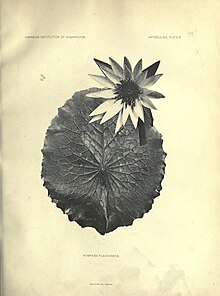
| |
| Nymphaea gracilis as Nymphaea flavovirens | |
| Scientific classification | |
| Kingdom: | Plantae |
| Clade: | Tracheophytes |
| Clade: | Angiosperms |
| Order: | Nymphaeales |
| Family: | Nymphaeaceae |
| Genus: | Nymphaea |
| Subgenus: | Nymphaea subg. Brachyceras |
| Species: | N. gracilis |
| Binomial name | |
| Nymphaea gracilis Zucc. | |
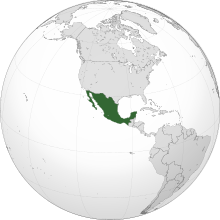
| |
| Nymphaea gracilis is endemic to Mexico | |
| Synonyms | |
| |
Nymphaea gracilis is a species of waterlily endemic to Mexico. It is the only species of its genus which is endemic to Mexico.
Description
Vegetative characteristics
Nymphaea gracilis has very short, subglobose rhizomes densely covered with fibrous roots. The petiolate, glabrous, orbicular floating leaves with dentate margins are 35–40 cm long, and 28–35 cm wide. The adaxial leaf surface is bright green, and the abaxial leaf surface is suffused with purple colouration. The terete, 1.2 cm wide petiole is 60–150 cm long.
Generative characteristics
The flowers are 8–10 cm wide, and extend up to 20–40 cm above the water surface. They have four lanceolate, green sepals and 18-20 white sepals. The androecium consists of 60 stamens. The gynoecium consists of 12-15 carpels. The globose 2–3.5 cm wide fruit bears arillate seeds with a reticulate testa, and trichomes. The flowers are fragrant.
Cytology
Generative reproduction
Nymphaea gracilis is facultatively xenogamous.
Taxonomy
Publication
It was first described by Joseph Gerhard Zuccarini in 1832.
Placement within Nymphaea
It is placed in Nymphaea subgenus Brachyceras.
Etymology
The specific epithet gracilis means thin, slender or graceful.
Conservation
It is considered to be in danger of extinction.
Ecology
Habitat
It grows in canals, swamps, shallow ponds,dams, and lakes.
Pollination
The three most important pollinators of Nymphaea gracilis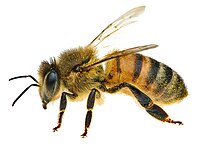 Apis mellifera
Apis mellifera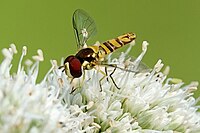 Allograpta obliqua
Allograpta obliqua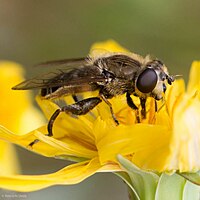 A member of the genus Asemosyrphus (Asemosyrphus polygrammus)
A member of the genus Asemosyrphus (Asemosyrphus polygrammus)
The flowers attract flies and bees. The bee species Apis mellifera is the most important pollinator of Nymphaea gracilis, followed by the fly species Allograpta obliqua, and Asemosyrphus sp.
Use
The rhizomes are eaten both by humans and livestock.
Cultivation
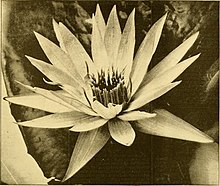
It has been used in artificial hybridisation to create new waterlily cultivars.
References
- ^ "Nymphaea gracilis Zucc". Plants of the World Online. Royal Botanic Gardens, Kew. Retrieved 30 December 2023.
- ^ Sandoval-Ortega, M. H. (2020). "Contribución al conocimiento de Nymphaea gracilis Zucc. en Aguascalientes, México." Tecnociencia Chihuahua, 14(1), 561-561.
- ^ Zuccarini, J. G. (1832). Plantarum novarum vel minus cognitarum descriptio, fasc. I. Abhandlungen Der Mathematisch-Physikalischen Classe Der Königlich Bayerischen Akademie Der Wissenschaften, 1, 362–363. http://www.biodiversitylibrary.org/openurl?ctx_ver=Z39.88-2004&rft.date=1832&rft.spage=362&rft.volume=1&rft_id=http://www.biodiversitylibrary.org/bibliography/10920&rft_val_fmt=info:ofi/fmt:kev:mtx:book&url_ver=z39.88-2004
- ^ Henkel, F., Rehnelt, F., Dittmann, L., Dittman, L. (1907). "Das buch der Nymphaeceen oder Seerosengewächse." pp. 59-60. Deutschland: F. Henkel.
- ^ Conard, H. S. (2015). The Waterlilies: A Monograph of the Genus Nymphaea (Classic Reprint). pp. 137-139. USA: FB&C Limited.
- ^ Zepeda-Gómez, C., Cruz-Muciño, E., Burrola-Aguilar, C., & Estrada-Zúñiga, M. E. (2020). "Floral biology, floral visitors, and reproductive system of Nymphaea gracilis Zucc.(Nymphaeaceae)." Botanical Sciences, 98(4), 499-515.
- Nymphaea gracilis | International Plant Names Index. (n.d.). Retrieved December 30, 2023, from https://www.ipni.org/n/171186-2
- Borsch, T., Löhne, C., & Wiersema, J. (2008). "Phylogeny and evolutionary patterns in Nymphaeales: integrating genes, genomes and morphology." Taxon, 57(4), 1052-4E.
- Missouri Botanical Garden. (n.d.-b). Deutzia gracilis - Plant Finder. Retrieved January 1, 2024, from https://www.missouribotanicalgarden.org/PlantFinder/PlantFinderDetails.aspx?kempercode=v560
- Drakaea gracilis Hopper & A. P. Br. (n.d.). Encyclopedia of Life. Retrieved January 1, 2024, from https://eol.org/pages/5950126/articles
- Passiflora gracilis | The Italian Collection of Maurizio Vecchia. (n.d.). Passiflora. Retrieved January 1, 2024, from https://www.passiflora.it/gracilis/319/eng/
- ^ Lot, A., Novelo, A. (2004). "Iconografía y estudio de plantas acuáticas de la ciudad de México y sus alrededores." pp. 128-129. Mexiko: UNAM. Instituto de Biología.
- CONABIO. (n.d.). Ninfa cabeza de negro (Nymphaea gracilis). EncicloVida. Retrieved January 1, 2024, from https://enciclovida.mx/especies/166039-nymphaea-gracilis
- Cordova, C. E. (2022). "The Lakes of the Basin of Mexico: Dynamics of a Lacustrine System and the Evolution of a Civilization." p. 69. Deutschland: Springer International Publishing.
- Kilbane, T. (n.d.). August Walking Tour – Water Gardens. Denver Botanic Gardens. Retrieved January 1, 2024, from https://www.botanicgardens.org/blog/august-walking-tour-water-gardens-1
| Taxon identifiers | |
|---|---|
| Nymphaea gracilis | |